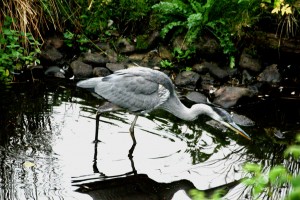 Attracting wildlife to gardens gives endless possibilities to help not only birds, but also hedgehogs, frogs and toads, red squirrels and many insects. If you look at a catalogue or visit a garden centre, the range of items from hedgehog houses to bird baths and butterflies nectar sources to red squirrel feeders. it can be bewildering. However, one item that is often not covered is one that can make a fundamental difference to a very wide range of wildlife – a garden pond. At the outset it may seem a very formidable task but there are ponds and ponds. A simple lined depression only a few feet across will attract wildlife whilst large ponds are even more worthwhile. Whilst many other aspects are important, from nestboxes to bushes, the garden pond is, arguably, even more valuable in wildlife terms.
Attracting wildlife to gardens gives endless possibilities to help not only birds, but also hedgehogs, frogs and toads, red squirrels and many insects. If you look at a catalogue or visit a garden centre, the range of items from hedgehog houses to bird baths and butterflies nectar sources to red squirrel feeders. it can be bewildering. However, one item that is often not covered is one that can make a fundamental difference to a very wide range of wildlife – a garden pond. At the outset it may seem a very formidable task but there are ponds and ponds. A simple lined depression only a few feet across will attract wildlife whilst large ponds are even more worthwhile. Whilst many other aspects are important, from nestboxes to bushes, the garden pond is, arguably, even more valuable in wildlife terms.
The first considerations are size and location. The golden rule over size is to make the largest pond you can. With my garden pond once it was formed I had to enlarge it twice which made it just more expensive and time consuming. Location is often dictated by practical concerns but try to avoid a pond near too many overhanging bushes or trees because of constant leaf litter. Two important issues, from the beginning, are depth and water levels. The depth at some point should be two feet to avoid being completely iced up in the winter. Water levels should be as constant as possible. Topping up, preferably by rain water is one way and this can be collected in water butts. Constant water levels mean more plants and wildlife. There should be some shallow margins so that the water warms up for young amphibians and insects to develop quicker.
Whatever the size of your pond, whether only a few feet across or larger, once the depression has filled up with water, from whatever source, decisions need to be made. If you leave it long enough plants and wildlife will naturally colonise the water. However, a much quicker way is to introduce plants, both aquatic and marginal, as this will attract wildlife from frogs to dragonflies. Now a word of warning over plants, as do not, under any circumstance, introduce not native plants. These are often offered by such places as garden centres and include plants such as exotic water lilies, but simply go, every time, for the native plants and these are just as freely available. Whether you keep fish in the pond is a personal choice but the presence of virtually any fish, including goldfish, will lead to a reduction in wildlife as they will eat a wide variety from tadpoles and eggs to nymphs of dragonflies and other insects. Depending on size, the ponds will attract many birds, not only to drink but also feed. For example the heron will come in for frogs, even on quite small ponds, and mallard are frequent visitors and may even nest on the margins.
Getting advice on garden ponds has never been easier. An increasing number of books on gardening for wildlife now covers the subject. At least one local garden centre sells liners and aquatic or marginal plants and has a leaflet on the subject. Better still look up “Froglife” on the computer and they will provide a comprehensive booklet on the subject and this organisation is by far the best source for advice. It is not too late to create a new pond this year and you will be surprised just how quickly it is colonised by various wildlife. The first dragonfly over the pond is always a thrill, as is the first frog calling.
Tags: highland wildlife
